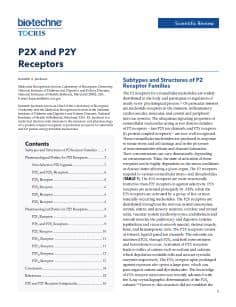NTPDase
Ectonucleotidases (also known as NTPDases, Ecto-ATPases, ectonucleoside triphosphate diphosphohydrolase) are constitutively expressed ectoenzymes that hydrolyze extracellular nucleotides. There are four known major families of ectonucleotidases.
NTPDase Inhibitors |
|
|---|---|
| Cat. No. | Product Name / Activity |
| 8173 | Adenosine 5'-(α,β-methylene)diphosphate disodium salt |
| Ecto-5'-nucleotidase (CD73) inhibitor | |
| 1283 | ARL 67156 trisodium salt |
| NTPDase inhibitor | |
| 2689 | POM 1 |
| Inhibitor of E-NTPDases | |
| 2573 | PSB 069 |
| Non-selective NTPDase inhibitor | |
| 6083 | PSB 12379 |
| Ecto-5'-nucleotidase (CD73) inhibitor | |
Ectonucleotidases (also known as NTPDases, Ecto-ATPases, ectonucleoside triphosphate diphosphohydrolase) are ectoenzymes that hydrolyze extracellular nucleotides. There are four major families of ectonucleotidases: CD39/NTPDases (ecto-nucleotide triphosphate diphosphohydrolases); ecto-nucleotide pyrophosphatase phosphodiesterases (E-NPPs); alkaline phosphatases; and ecto-5'-nucleotidases/CD73.
NTPDases are constitutively expressed in many tissues and can be differentiated on the basis of cellular location. NTPDases 1, 2, 3 and 8 are located on the cell surface; NTPDases 5 and 6 are localized within the cell and undergo secretion after heterologous expression; and NTPDases 4 and 7 are entirely intracellularly located and face the lumen of cytoplasmic organelles. NTPDases located at the cell surface require Ca2+ or Mg2+ ions for activity. These subtypes contribute to the recycling of nucleosides from salvage pathways and extracellular nucleoside phosphates.
Due to their role in nucleotide metabolism, NTPDases help control the availability of extracellular nucleotide agonists at P2 receptors and modulate P2 receptor function as a result. The distribution of P2 receptors throughout the body, and the wide-spread nature of purinergic signaling, suggests a vital role for NTPDases in a range of cellular processes. For example, NTPDase1 - the predominant ectonucleotidase in vasculature - has therapeutic potential in alleviating thrombotic and inflammatory stress. NTPDases are also found throughout the nervous system, where they have been shown to directly control the function of the P2 receptors there.
Location, substrate preference and hydrolysis rates vary between subtypes; however, all NTPDases contain five highly conserved sequence domains, known as apyrase conserved regions (APCR1 to APCR5).
External sources of pharmacological information for NTPDase :
Literature for NTPDase
Tocris offers the following scientific literature for NTPDase to showcase our products. We invite you to request* your copy today!
*Please note that Tocris will only send literature to established scientific business / institute addresses.
NTPDase Gene Data
| Gene | Species | Gene Symbol | Gene Accession No. | Protein Accession No. |
|---|---|---|---|---|
| NTPDase 1 | Human | ENTPD1 | NM_001776 | S73813 |
| Mouse | Entpd1 | NM_009848 | P55772 | |
| Rat | Entpd1 | NM_022587 | P97687 | |
| NTPDase 2 | Human | ENTPD2 | NM_203468 | U91510 |
| Mouse | Entpd2 | NM_009849 | O55026 | |
| Rat | Entpd2 | NM_172030 | O35795 | |
| NTPDase 3 | Human | ENTPD3 | NM_001248 | AF039917 |
| Mouse | Entpd3 | NM_178676 | Q8BFW6 | |
| Rat | Entpd3 | NM_178106 | Q80Z26 | |
| NTPDase 4 | Human | ENTPD4 | NM_004901 | AJ131358 |
| Mouse | Entpd4 | NM_026174 | Q9DBT4 | |
| Rat | Entpd4 | NM_001108384 | NP_001101854 | |
| NTPDase 5 | Human | ENTPD5 | NM_001249 | AF039918 |
| Rat | Entpd5 | NM_199394 | NP_955426 | |
| NTPDase 6 | Rat | Entpd6 | NM_053498 | NP_445950 |
| NTPDase 7 | Human | ENTPD7 | NM_020354 | AF269255 |
| Mouse | Entpd7 | NM_053103 | Q3TCT4 | |
| Rat | Entpd7 | NM_001107595 | NP_001101065 | |
| NTPDase 8 | Human | ENTPD8 | NM_198585 | AY359088 |
| Mouse | Entpd8 | NM_028093 | Q8K0L2 | |
| Rat | Entpd8 | NM_001033565 | Q5DRK1 |
